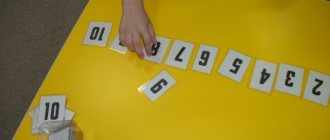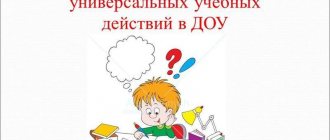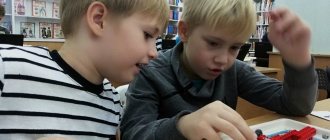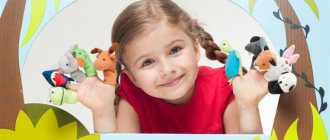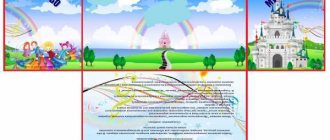Article: Development of time concepts in preschool children
Wise allocation of time is the basis for activity. Y. A. Komensky
Time and space are the most difficult categories for preschool children to understand. They become available when modern technologies for developing spatio-temporal concepts in children are used in the pedagogical process. One of the leading tasks of cognition of time relations already in preschool age is to enable the child to discover the interrelations of certain objects and phenomena of the surrounding world, in particular the sequence of actions (events) in time. Time as an objective reality characterizes the duration and pace of real processes, as well as their sequence. What is commonly called “perception of time” is nothing more than a reflection of objective time in a person’s consciousness. Phenomena of reality are characterized by a certain duration, therefore the perception of time is, first of all, a reflection of the duration of phenomena, their flow within a particular period of time. The perception of time is also a reflection of the speed of objective processes, i.e. their pace. In objectively existing time, events follow one after another, so the perception of time involves reflecting the sequence of phenomena, events, and actions.
Direct perception of temporal duration is expressed in the ability to evaluate it and navigate in time without aids. This ability is called the “sense of time.” In different types of activities, the “sense of time” acts as a sense of tempo, speed or duration. In the formation and development of this feeling, the accumulated experience of estimating the duration of periods of time plays a large role. An indicative experiment was conducted by L.A. Wenger and V.S. Mukhina, the essence of which was to confirm the position that the ability to determine short periods of time depends on what the child managed to do during this time. The older preschoolers were told that they would be tested on their ability to tell time and were asked to draw, telling them that they needed to draw for exactly 3 minutes. The work began and ended at the teacher’s signal. After this, the children were asked to start drawing again on a blank sheet of paper at a signal (the previous drawings were removed), but to finish at their own discretion - when 3 minutes had passed. Most of the children began to draw the same objects that they had just depicted. When the guys were asked: “Why do you repeat the same drawing, because drawing the same thing is not interesting?”, they replied that they would draw for as long as given. Indeed, the children drew for about 3 minutes (from 2.5 to 3.5 minutes). When the children were asked to draw something new, also in 3 minutes, the fluctuations over time were somewhat larger (from about 2 to 4 minutes). It is also difficult for children to understand the meaning of words denoting temporary relationships due to their relativity. For preschoolers, it is not always clear, for example, the words now - now or today - yesterday - tomorrow. Therefore, they often ask adults: “Is it already tomorrow or is it still today?”, “Today is tomorrow?” etc. However, SL. Rubinstein argued that one should not exaggerate the inaccessibility of temporary concepts for children and that their development is relatively late when “not enough attention is paid to their development.” In his opinion, verbal reflection of the categories of time begins at about one and a half years of age. Initially, adverbs appear that define the time sequence: now, first, now. Preschoolers develop a clear idea of the past, present and future tense for specific events. Children talk about days, months, hours as if they were objects and even “animate” time: “Where did yesterday go?” The child lives in the present time and in the present: through games, events, so his idea of the present time is the most accurate. Historical time (its depth) is inaccessible to a preschooler. In his personal experience there is not and cannot be a support (measurement) for counting long-past time. Because of this, the child’s question “Where does Peter the Great live now?” quite appropriate. As experience in time orientation accumulates, some objective phenomena begin to be used as indicators: “It’s morning now, it’s light, the sun is rising, and night is when it’s dark and everyone is sleeping.” Preschoolers often localize in time events that have distinctive qualitative features, emotional appeal, and are familiar to them: “Christmas tree - when it’s winter; We’re going to the dacha when it’s summer”, etc. Children 5-6 years old are already actively using tense adverbs. But not all time categories are recognized by them and correctly reflected in speech: adverbs denoting the speed and localization of events in time (long ago, quickly) are better learned, while adverbs expressing duration and sequence are worse - adverbs expressing duration and sequence (after, long, soon). The process of verbal expression of temporary concepts in children 5-6 years old is in a stage of continuous development. However, fine differentiation of time relations in preschool age is formed slowly and largely depends on the general mental and speech development of children. Preschool children's ideas about time are associated with the ability to navigate the time of day by natural phenomena, with the idea of the cause-time dependencies of rhythmic natural phenomena, with the mastery of time concepts (at dawn, at dusk, at noon, at midnight, day, week, month , year). Most children do not notice differences in the color of the sky at different periods of the day, and cannot establish the sequence of parts of the day. In their minds, the day ends at night and begins in the morning. Often preschoolers cannot determine the sequence of the days of the week. There is unevenness in remembering the days of the week; days that have a pronounced emotional connotation for the child are better remembered. This feature is also manifested in children’s memorization of the names of the months. So, a 4-year-old child, when asked by an adult, “What is the name of the first day of the week?” answered: “Kindergarten.” Older preschoolers' knowledge of how to measure time (using a calendar, clock) is insufficient. The names of time intervals (minute, hour) remain purely verbal and abstract for children, since they have not yet accumulated life experience in activities during these periods of time. Experience shows that preschoolers are able to estimate the duration of one minute, but this estimate depends on the type of activity in a given period of time. Positive emotions in children that arise during an interesting activity make them want to prolong it. Therefore, when assessing time filled with events of interesting and rich content, the child allows an overestimation of the short time that passes unnoticed and the duration of which seems shorter. Time filled with monotonous, uninteresting activities seems longer to the child. The influence of these subjective factors can be significantly weakened as a result of the development in children of a “sense of time”, the accuracy of assessing various time intervals under the influence of specially organized exercises. Methodology for the development of time concepts in preschool children Time is perceived by the child indirectly, through the concretization of time units and relationships in constantly recurring phenomena of life and activity. Children's ideas about such periods of time, the skill of distinguishing which is formed on the basis of personal experience, are more accurate. Therefore, children need to be introduced to small time intervals that can be used to measure the duration of actions in different types of activities. Measures of time (second, minute, hour, day, week, month, year, century) represent a certain system of time standards, where each measure is added up from the units of the previous one and serves as the basis for constructing the next one. Therefore, children’s acquaintance with units of time measurement should be carried out in a strict system and sequence, where knowledge of some time intervals, the ability to determine and measure them, would serve as the basis for knowledge of the following and reveal to children the essential characteristics of time: its fluidity, continuity, irreversibility. The question arises: in what order should children be introduced to these measures of time? What measure of time should I start with? In everyday life at home and in kindergarten, children early develop more or less definite ideas about the real duration of such periods of time as morning, noon, evening, night. Consequently, the teacher has the opportunity to clarify and concretize the knowledge of children (from 3 years old) about the parts of the day, to develop their skills in recognizing and naming these parts of the day. Children aged 4-5 years should develop ideas about the sequence of parts of the day and about the day as a whole; you need to familiarize yourself with the meaning of the words yesterday, today, tomorrow. Children of older preschool age can be introduced to the week, months, and year. At the same time, it is necessary to develop the very sense of time; introduce the durations of such time measures as 1 minute, 3, 5, 10 minutes, half an hour and an hour; learn to use time measuring instruments such as hourglasses and regular clocks. Along with this, it is necessary to train children in the ability to independently isolate the time sequence in the course of the phenomena and actions under consideration. Mastering the sequence of parts of the day The day is usually divided into four parts: morning, afternoon, evening, night. This division, on the one hand, is associated with objective changes occurring in the environment (due to different positions of the sun, illumination of the earth's surface, airspace, the appearance and disappearance of the moon, stars), and on the other hand, with a change in types of human activities, with alternating work and rest. The duration of each part of the day is different, so their change is accepted conditionally. Among the various types of activities that are repeated daily in a child’s daily routine, there are constant ones that take place only once a day, at a certain time: coming to kindergarten, morning exercises, lunch, afternoon nap, etc. There are also variable types activities that are repeated several times during the day, in different parts of the day: games, washing, dressing and undressing, walking, etc. They can also be used as indicators of parts of the day. In order to determine the parts of the day and their sequence, pictures are used depicting permanent activities characteristic of each part of the day. The question is asked: “When does this happen?” Then you are asked to select those pictures that show what happens in any period of the day (morning, afternoon, evening or night). Reading excerpts from stories, poems that describe practical actions characteristic of each part of the day, and riddle games (“When does this happen?”) lead to the accumulation of experience in time orientation. After children learn to associate parts of the day with a particular activity, their attention should be focused on objective indicators that symbolize time (position of the sun, degree of illumination of the earth, color of the sky, etc.). In what follows, the color symbol is used as a symbol. At the end of the year, when children already have ideas about the parts of the day, it is advisable to help them understand the meaning of the word day, excluding the quantitative characteristics of this measure (24 hours). The word day should act as a generalization: a day consists of four parts - day, evening, night and morning. It is necessary to help children realize that day, evening, night, morning are parts of the whole, the day; that the sequence of parts of the day can be counted starting from any of them. You can talk with children of middle preschool age about the meaning of words today, yesterday, tomorrow. To do this, you need to talk about one bright and significant event for children three times: first, that the puppet show will take place tomorrow; then - that the puppet show will be shown today; and, finally, that it was shown yesterday. This allows the child to “get closer” to understanding the fluidity and continuity of time. Getting to know the calendar Calendar time is certain periods of time, the duration of which is fixed by social experience in generally accepted measures of time: days, weeks, months, years. Children of older preschool age, as a rule, have rather inaccurate, fragmentary ideas about calendar time. Memorizing the names and sequence of days of the week and months does not give an idea of the duration, capacity of time, its fluidity, irreversibility, change and periodicity. Reading V. I. Dahl’s story “The Old Man of the Year” to children and talking about what they read will help them establish the relationship between time standards: year, month, week, day. The one-year old man came out. He began to wave his arms and let the birds fly. Each bird has its own special name. The old one-year-old waved for the first time - and the first three birds flew away. There was a whiff of cold and frost. The old man waved a second time - and the second troika flew off. The snow began to melt, flowers appeared in the fields. The old man waved a third time - the third troika flew. It became hot, stuffy, sultry. The men began to reap rye. The old one-year-old waved for the fourth time, and three more birds flew. A cold wind blew, frequent rain fell, and fog settled in. But the birds were not ordinary. Each bird has four wings. Each wing has seven feathers. Each feather also has its own name. One half of the feather is white, the other is black. The bird flaps once and it becomes light-light; if it flaps again, it becomes dark-dark. It is advisable to ask children the following questions.
- What kind of birds flew out of the old man's sleeve?
- What are the four wings of each bird?
- What are the seven feathers in each wing?
- Why is every feather one half white and the other half black? Using a tear-off calendar, the time of holidays is determined, which arouses children's interest in tracking events over time. The calendar helps to understand the sequence of seasons, which are associated with seasonal changes, which are also the subject of study. In older preschool age, interest in various parameters of time develops: a 5-6 year old child is interested in the duration of a particular phenomenon, the quantitative characteristics of time measures, and time measuring instruments. Familiarity with the calendar is necessary in terms of preparing children for school, getting used to a firm schedule of classes by hour and by day of the week.
Mastering knowledge about calendar standards presupposes the ability to measure time using generally accepted instruments. Older preschoolers already have the necessary stock of quantitative ideas about the length of the day, which facilitates their development of ideas about the numbers of the month, days of the week, and week; about months, calendar year. In order for this complex system of interconnected units of time to be understood by children, it must be presented in the form of some kind of calendar model, reflecting in material form the relationships between units of time (examples of such models are presented in Fig. 5, 6 color tabs). The calendar will help children visualize a relatively long period of time, a month or even a year. At one time, F.N. Blecher wrote that the tear-off calendar gives a clear idea that “days are passing,” “events are approaching,” a month has passed and a new one has begun. F.N. Blecher warned that there was no question of memorizing with children the sequence of days of the week, months, and their names. Instead, she recommended using a tear-off calendar as the most visual means of measuring time. Children easily learn that a leaf is a day; To pick the next leaf, you have to wait a whole day. Development of a sense of time in children of senior preschool age A developed sense of time (the ability to determine time intervals without a clock) encourages the child to be more organized and collected. To do this, first of all, it is necessary to develop a sense of time in children; create special situations, focusing preschoolers’ attention on the duration of various vital time intervals; show what can be done in these periods of time; to teach in the process of activity to measure and then evaluate time intervals; calculate your actions and perform them at a predetermined time. For the successful development of a sense of time in children, the following is necessary.
- The experience of time is the idea of the duration of time intervals. To do this, it is necessary to organize a variety of activities for children within time periods, which will give them the opportunity to feel the length of time and imagine what can actually be done in one or another period of time. In the future, this will serve as the basis for developing the ability to plan one’s activities over time, that is, to choose the amount of work according to the time that needs to be spent to complete it.
- Development in children of the ability to estimate time intervals without a clock. Self-control and control by adults will help them improve the adequacy of their assessments.
Children 5-6 years old can develop a sense of time at intervals of 1, 3, 5 and 10 minutes. Distinguishing these intervals is vital for children: 1 minute is the initial unit of time accessible to children, from which 3, 5 and 10 minutes are added up. This measure of time is most common in the speech of others. The methodology developed by T. D. Richterman includes the following points: familiarizing children with time intervals of 1, 3, 5, 10 minutes (in this case, a stopwatch or hourglass should be used for children to perceive the duration of these intervals); ensuring the experience of the duration of these intervals in different types of activities; learning the ability to perform an activity within a specified period (1, 3, 5 minutes), for which the duration of the activity should be assessed and the pace of its implementation should be regulated. First, it is necessary to train children in performing an hourglass activity (children do something in 1 minute and control the time using a one-minute hourglass); This ensures the accumulation of experience in using the measure. The teacher constantly evaluates the children’s ability to control time using an hourglass, demonstrates the duration of a minute on a stopwatch, explaining that a full revolution of the hand always takes 1 minute. Then children practice estimating the duration of a time interval during an activity. The teacher pays attention to the accuracy of duration assessment. And finally, the adult helps children develop the ability to pre-plan the amount of activity for a specified period of time based on the child’s idea of its duration. Checking the planned plan for completing the amount of work is carried out using an hourglass. Subsequently, children begin to transfer the ability to estimate the duration of time periods into everyday games and activities. Children independently choose the amount of work corresponding to an interval of 1 minute, answering the question “What can you do in 1 minute?” Preschoolers' mastery of three- and five-minute intervals is carried out using the same methodology. Children should perceive an interval of 5 minutes as a value derived from 1 minute: the minute hourglass will be turned over five times, the hand on the stopwatch will go around the circle five times. Thus, the perception of a new time interval will occur on the basis of the children’s already existing knowledge about the duration of the 1st and 3rd minutes. Familiarization with the 10-minute interval can be carried out during various classes in which children are asked to complete a particular task within 10 minutes. It is advisable to teach children the ability to determine the time on a clock and familiarize them with the structure of a clock using models. The teacher, together with the children, finds out the difference between the clock and the model, and clarifies the purpose of the clock hands. You can invite the children to place the large hand on the number 12, and move the small hand from number to number and determine what it shows, i.e. exactly 8, 9, etc. o’clock. Then the children learn that the minute hand, moving in a circle, travels a whole circle in 1 hour. And if the circle is divided in half (on a clock model you can cover half of the dial with a colored semicircle), you get two halves of the circle. An arrow travels half a circle in half an hour. This is how children learn the structure of a clock, the purpose of the large and small hands, and the method of showing an hour. Then children learn to show “half an hour”, for example, half of the second hour, then a quarter (if necessary, the circle is divided into 2, 4 parts). Children constantly watch the passage of time using a clock, and as they carry out any activity, they move the hands to set the same time on a toy clock (model). During the pedagogical process in kindergarten, it is possible to train children in the ability to carry out activities within a specified time, teach them to determine the duration themselves and plan in advance the possible amount of work for a given period of time within 5-20 minutes. In such conditions, children study more organizedly, are less distracted, regulate the pace of their activities and achieve more. Developing in children the ability to understand the relationships of time sequence It is important for a 5-6 year old child to be able to consistently consider this or that phenomenon, object, picture, express his thoughts, perform operations in sports and any productive activity. To do this, you need to be able to isolate the time sequence when performing content and be able to reproduce it or establish it again. Self-mastery of these skills is difficult. Consequently, we need specially developed and introduced into the learning process techniques aimed at isolating, restoring and establishing a time sequence that will make it possible to master the necessary methods of action. The content on which children will establish a time sequence should be familiar to them; the links highlighted in it are significant and carry certain information; the emotional intensity of the selected links should be approximately equivalent. To do this, it is necessary to create a model of a sequential series, where individual links with intermediate elements, indicated by symbols, are located from beginning to end. An adult together with a child can create a situation of the growth and development of a plant, the growth and maturation of a child, the development of an insect, using models, pictures and interrelated illustrations, as well as literary texts. Teaching children of senior preschool age to establish time sequence is carried out according to the following plan:
- in the development of an object (event), a time sequence is identified;
- the time sequence is reproduced on the model using symbols;
- the sequence is recreated with a programmed error, which is corrected by the children;
actions in a given sequence are performed without a model. The experience of teaching children the ability to establish a time sequence shows that in such conditions preschoolers feel more confident and independent (T.D. Richterman).
The concept and essence of temporary representations
Definition 1
The development of temporal representations is one of the aspects of the mathematical development of preschool children.
In the process of becoming familiar with the world around them, children are faced with such a concept as “time”. Features of the perception of time by preschool children are the indirectness and confusion of spatio-temporal concepts, as well as children’s insufficient knowledge of speech categories for denoting time. It is quite difficult for preschoolers to understand that time is in constant motion, it moves from the past to the future in one direction, it cannot be stopped, delayed or returned, and it cannot be “showed”. In this connection, even older preschoolers doubt its existence.
As practice shows, perception and understanding of time is one of the most difficult categories for preschool children. That is why preschool pedagogy is in constant search and development of methods and means for the formation and development of temporal representations.
Finished works on a similar topic
- Course work Development of time concepts in preschool children 400 rub.
- Abstract Development of time concepts in preschool children 260 rub.
- Test work Development of time concepts in preschool children 220 rub.
Receive completed work or specialist advice on your educational project Find out the cost
Note 1
The significance of the formation of temporal concepts in preschool children is that they are extremely necessary in the subsequent formation of “scientific” and “everyday” concepts.
The main tasks of forming temporary representations in preschool children:
- Formation of primary practical orientation in time.
- Familiarization with individual time standards (week, year, day, etc.).
- Formation of initial concepts and ideas about some properties of time (fluidity, one-dimensionality, periodicity, irreversibility, etc.).
A variety of methods are used to form and develop time concepts in preschool children. The most effective of these are simulations, games and exercises.
